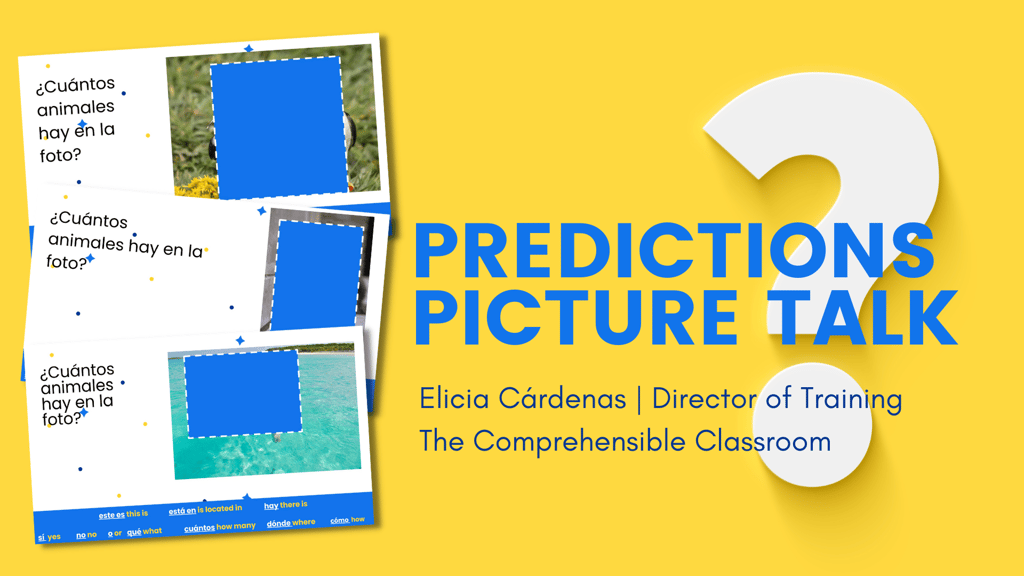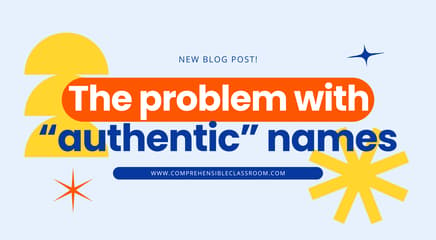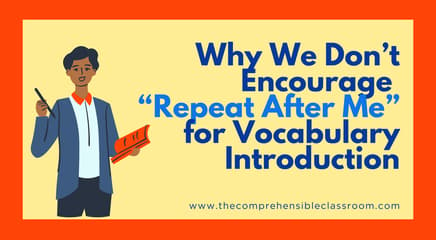One of my favorite ways to introduce very high frequency vocabulary for novice learners is to use pictures. Describing an image to students in the target language while they listen and look while I point to various elements of the picture is an excellent way to provide my students with input that is comprehensible. One day, with a desire to add an element of intrigue, I added a twist: instead of simply showing a picture and talking about it, I layered in a fun element of prediction! My students LOVED it, and I know yours will, too.

Pictures + questions: predictions!
Blog post by Elicia Cárdenas, Director of Training
In all levels of language classes, I like to ask students to make predictions about what they are going to see or what will happen, and then to back up their predictions with evidence. Such conversation is often rich and interesting. That being said, asking students for evidence in the target language to support inferences isn’t something that Novice learners are prepared to do on Day 1 of a language class. Since I knew that I would want to introduce this kind of conversation early on in the year, I knew I would need to scaffold it. In this post, I will describe a simple, Novice-friendly way to have fun with predictions and build a foundation for deeper conversation later on in the year.
Prep for predictions: Make a plan for communication
In order to create a simple prediction activity for high frequency language, I first had to decide what high frequency language to focus on. Since the Internet is a never-ending source of adorable animal photos that bring me joy and seem to be universally loved by humans of all ages, I chose animal photos as the content. Then, I chose to focus on the high frequency vocabulary this is, there is, calls him/her/themself, and is located while discussing the pictures. I also decided to focus on asking a question with the word “how many”, because it seemed like a good way to begin a prediction. I also believe that we need to show students lots and lots of examples of questions in the target language!
The purpose for choosing this vocabulary was not to have a set of words that students would know by the end of the activity; it was a plan for me to help my students understand everything that I said during the activity. I knew that if I repeated the same words as I described each picture, or at least many of the pictures, my students would be more likely to understand what I was saying in the target language.
I found some adorable pictures of animals and created a very simple slideshow, quickly dropping the images into the Slides. Since I especially loved the images from Comedy Wildlife Awards and was hoping to use them, I emailed them to request permission to use their images. They said, "yes!", so I followed their guidelines for use and citing them as the source. Although I do not have permission to distribute those images in my Slideshow, it would be very easy for anyone to find Public Domain images that can be used in the classroom and even distributed freely on the Internet (try a 'cute animals' search on Pexels!). Whenever you use images, be sure to check the licensing information to make sure that you are honoring the work of the creator… and keeping yourself out of trouble!
Comedy Wildlife Awards has zillions of images, so I chose to work specifically with their images that featured animals that have similar names in English and the target language (which, for me, was Spanish). This included words like koala, león, cebra, and elefante. Of course, I couldn’t share cute animal photos with my class without using pictures of my own cute pets-- so perro (dog) and gato (cat) made their way in as well.
Remember - you can do this activity with any content-- it doesn't have to be cute animals!
Create a Predictions slideshow
This activity does require some prep because you will need to display covered-up images to students. This can be as simple as placing the image of an animal in one slide and then placing an opaque shape on top of it, and then duplicating the slide and deleting the image from the second slide so that when you advance to it, you reveal the image.
You can make it more complex by adding text to the slides, like I did in this example:


You can download a slide template with image placeholders FREE from our Subscriber Library! Check the Whole Class Activities folder and find it in the Predictions sub-folder.
How to run the Predictions activity in class
This activity is that it is SO easy to run in class, and it can take up as much or as little time as you'd like.
Step 1: Establish meaning
Show students the vocabulary that you plan to use repeatedly throughout the activity, and tell students what each term means in your shared language. I did this by writing the new vocabulary and its meaning on a slide, and then I read the words and their meaning aloud to and taught them a gesture for each one.
Step 2: Introduce the activity
I told the class in English, “Class, I’m going to ask you to make a predicción about some pictures I show. What is a prediction? Yes, it’s a guess”. Even though the word prediction is a cognate in the language that I teach–its Spanish counterpart predicción--I didn’t want to assume that every student would make that connection or would even know what a prediction is–so this quick introduction ensured that everyone was on the same page about what was going to happen during this activity.
Step 3: Make and discuss predictions
I showed students an image that was almost entirely covered up by a solid shape. With the image covered, I led a discussion that looked something like this (click here to access a translated version of this script):
Me: Ok: ¡predicción! ¿Cuántos animales hay en la foto? What am I asking? Yes- how many animals are in the picture?
¿Hay un animal (gesture with one finger) o dos animales (gesture with 2 fingers) en la foto? ¿Un animal o dos?
Students: Held up 1 or 2 fingers
Me: (Counting the number of students with 1 finger up) En la opinión de 13 estudiantes, hay un animal en la foto.
Me: ¿Cuántos animales hay en la foto? (Advance to next slide: same image, but the coverup image is gone, revealing the photo).
Me: Hay un animal. Este animal es un ave. En la foto, hay un ave. ¿Hay dos aves? (Wait for responses, verbal or gestured.) No, no hay dos aves. Hay un (1) ave.
Me: Clase, ¿cómo se llama el ave?
Students: Call out suggestions for the bird’s name
Me: (Choosing one of their ideas) Sí, este ave se llama Freddy. Advance to next slide with a new, covered up image.
Me: OK, predicción: ¿Cuántos animales hay en la foto? ¿Hay 2 animales (show 2 fingers) o hay cinco animales (show 5 fingers)?
Students: Show their response with the number of fingers.
Me: (Highlighting one student’s response) En la opinión de Jayne, hay cinco animales. Reveal photo. ¡Hay dos animales! Estos animales son gatos. Esto es un gato y esto es otro gato. Hay dos gatos en la foto. ¿Dónde están (point to the meaning of están at the bottom of my slide and do the gesture) los gatos? ¿Los gatos están en McDonalds®? No, no están en McDonalds. Los gatos están en un dormitorio. In a bedroom! ¿Cómo se llaman los gatos?
Students: Call out suggestions for names
Me: (Choosing two of their ideas) Los gatos se llaman Fluffy y Puffy. Fluffy y Puffy son gatos. Fluffy y Puffy están en un dormitorio.
Repeat for as many images as students continue to be interested in the activity or until you run out of time or content– whichever comes first!
What makes Predictions a great activity
What I loved about this activity for my own classes, and the reason that teachers that have attended my workshops love it as well, is that it sets up all students to be successful.
First, by asking very simple questions about images with obvious subjects, and then going a step further and linking meaning to our shared language, it is easy for students to understand everything that is said in the target language.
Second, students that have no prior knowledge or exposure to the target language are able to express their ideas in this activity just as well as students that already have some proficiency in the language. Students are able to express their ideas through gesture and single word answers, making it a perfect activity to boost confidence for budding language learners.
Another way in which this activity really levels the playing field is that it is impossible to know the answer, and so all predictions are just guesses. It does not matter what a student’s academic performance looks like in other classes nor what prior knowledge they have about animals or about the language; everyone has an equal opportunity to get their prediction right or wrong. This is a great opportunity for students who are afraid of getting it wrong to let down their guard and just enjoy the moment together.
Try out Predictions with your classes
While my permission from Wildlife Comedy Awards does not allow me to share the slideshow that I used with my students, I am happy to share a simple template that you can use with your own classes.
If you try out the Predictions activity, we’d love to hear how it goes! Please tag @comprehensibleclassroom in any posts on social media, and link to this blog post.
You can find the Predictions template in the Whole Class Activities folder in The Comprehensible Classroom’s subscriber library. Look for the Predictions sub-folder!
Elicia Cárdenas is the Director of Training for The Comprehensible Classroom. Elicia travels throughout North America to work with districts and organizations that represent teachers who are ready to transform their classroom instruction through Comprehension-based instruction. Elicia is also the founder of the Deskless Classroom.
Click here to book Elicia for a training at your school or organization.




